ROBOWORKS STM32F103RC Mecabot Autonomous Mobile Robot
Product Usage Instructions
Powering On the Mecabot
- To power on the Mecabot, ensure the battery is properly charged.
- Press and hold the power button until the robot’s systems initialize.
Controlling the Mecabot:
- Use the provided remote control app or optional physical remote control to navigate the Mecabot. Follow the instructions in the user manual for specific controls.
FAQ
- Q: How do I charge the battery of the Mecabot?
- A: To charge the battery of the Mecabot, connect the provided smart charger to the robot’s charging port and a power source. Allow the battery to charge fully before disconnecting.
Summary
Mecabot is an educational and research robot based on ROS (Robot Operating System) for robotic researchers, educators, students and developers.
Mecabot is equipped with builtin ROS Controller, LiDAR, Depth Camera, STM32 Motor/Power/IMU Controller and metal chassis with omnidirectional mecanum wheels.
Mecabot is ideal for ROS beginners with affordable price, compact design and ready-to-go package. Mecabot is also a solid Autonomous Mobile Robot (AMR) platform for robotic education and research projects.
Mecabot comes with four varieties:
- Mecabot 2 – Suitable for ROS beginners and low budget projects.
- Mecabot Pro – An ideal Autonomous Mobile Robot (AMR) platform for robotic education, R&D projects and rapid prototyping.
- Mecabot Plus – An ideal Autonomous Mobile Robot (AMR) platform for indoor service robot applications. This category is serious enough to be considered for industrial and commercial development.
- Mecabot X – An ideal Autonomous Mobile Robot (AMR) platform for indoor service robot applications with full metallic enclosure.
Mecabot comes with popular ROS controllers such as:
- Jetson – Orin Nano
- Jetson – Orin NX
Key Components
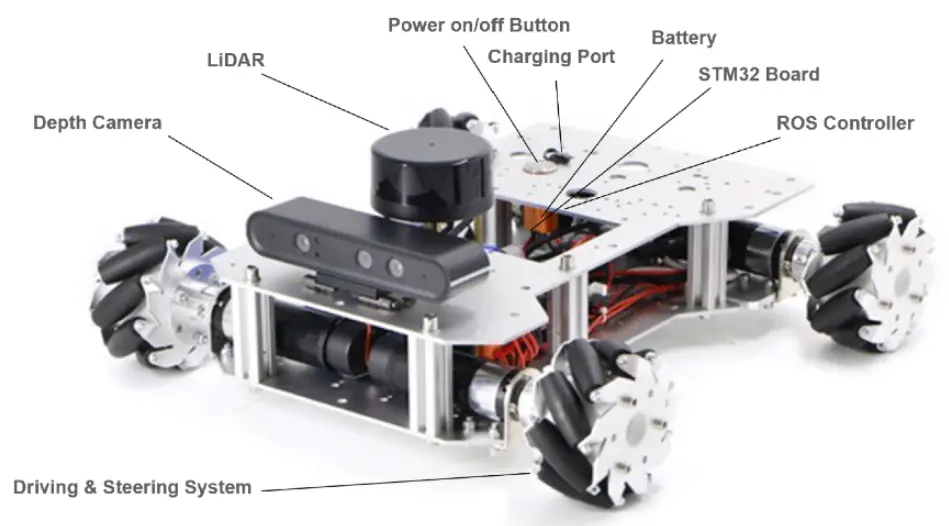
Models
| Variation | Image |
| Mecabot 2 | 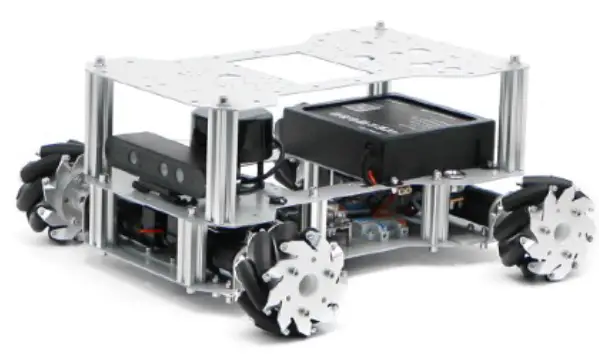 |
| Mecabot Pro |  |
| Mecabot Plus | 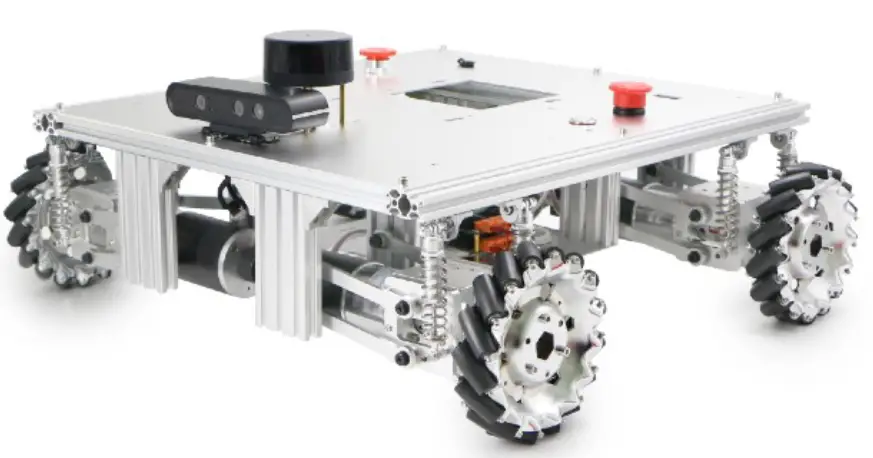 |
| Mecabot X | 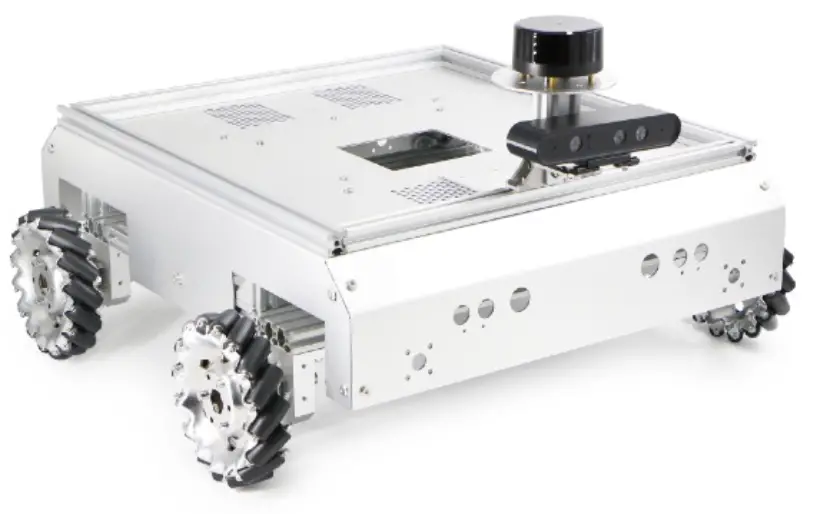 |
Product Specifications
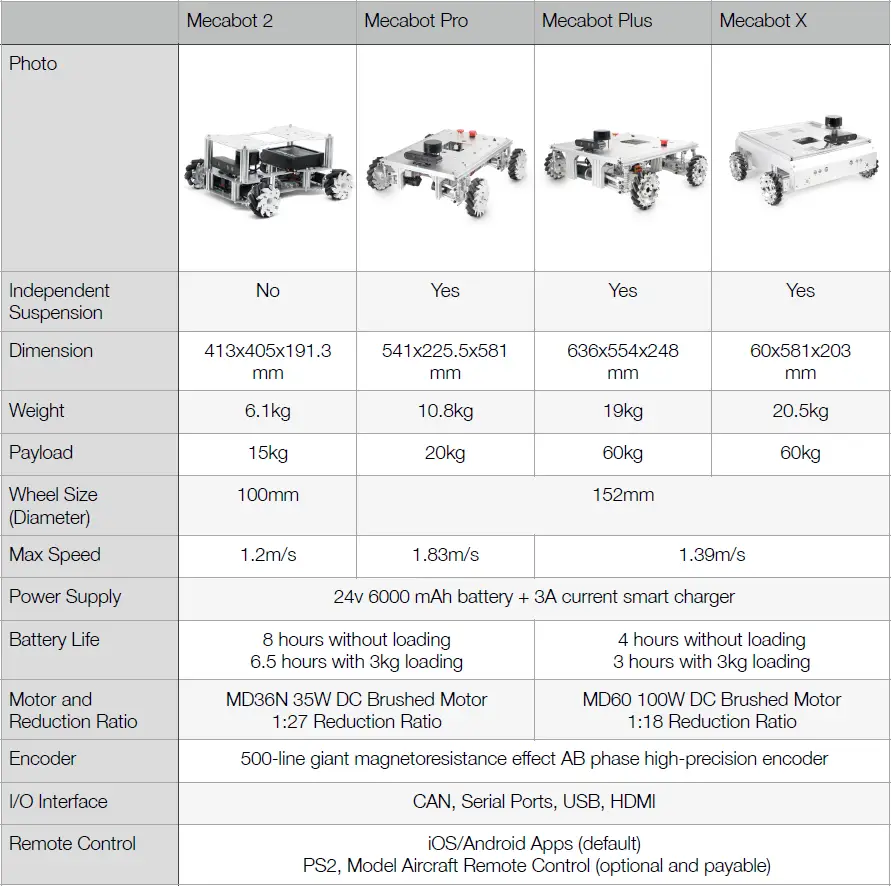
Introduction of ROS Controllers
There are 2 types of ROS Controllers available for use with the Mecabot based on Nvidia Jetson platform. Jetson Orin Nano is ideal for education and research. Jetson Orin NX is used more often in prototyping and commercial applications.
The following table illustrates the main technical differences between the various controllers available from Roboworks. Both boards allow high level computation and are suited towards advanced robotic applications such as computer vision, deep learning and motion planning.
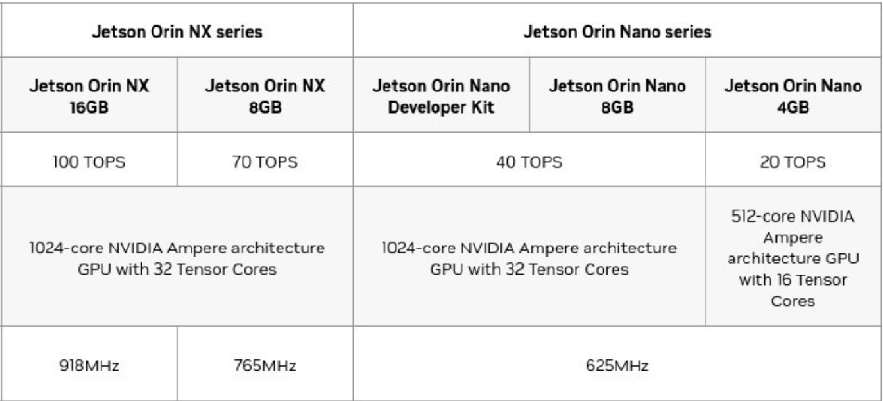
Sensing System
Sensing System: LiDAR & Depth Camera
A Leishen LSLiDAR is installed on all Mecabot variations with either the N10 or M10 model being used. These LiDAR’s offer a 360 degree scanning range and surroundings perception and boast a compact and light design. They have a high Signal Noise Ratio and excellent detection performance on high/low reflectivity objects and perform well in strong light conditions. They have a detection range of 30 metres and a scan frequency of 12Hz. This LiDAR integrates seamlessly into the Mecabots, ensuring all mapping and navigational uses can be easily achieved in your project.
The below table summaries the technical specifications of the LSLiDARs:

Additionally, all Mecabots are equipped with an Orbbec Astra Depth Camera, which is an RGBD camera. This camera is optimized for a rage of uses including gesture control, skeleton tracking, 3D scanning and point cloud development. The following table summarizes the technical features of the depth camera.

STM32 Board
STM32 Board (Motor Control, Power Management & IMU)
The STM32F103RC Board is the micro-controller used in all Mecabots. It has a high performance ARM Cortex -M3 32-bit RISC core operating at a 72MHz frequency along with high-speed embedded memories. It operates in -40°C to +105°C temperature range, suiting all robotic applications in worldwide climates. There are power-saving modes which allow the design of low-power applications. Some of the applications of this micro-controller include: motor drives, application control, robotic application, medical and handheld equipment, PC and gaming peripherals, GPS platforms, industrial applications, alarm system video intercom and scanners.
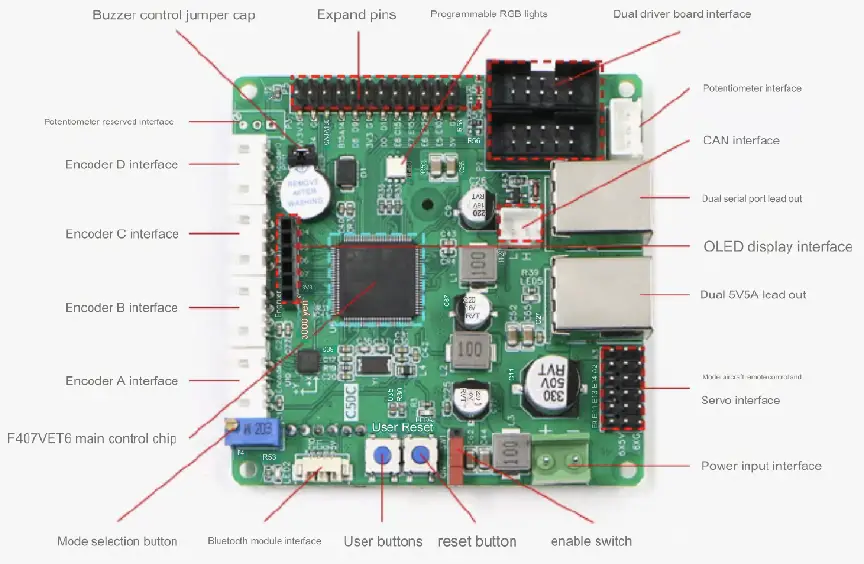
STM32F103RC / Features
| STM32F103RC | Features |
| Core | ARM32-bit Cortex –M3 CPU Max speed of 72 MHz |
| Memories | 512 KB of Flash memory 64kB of SRAM |
| Clock, Reset and Supply Management | 2.0 to 3.6 V application supply and I/Os |
| Power | Sleep, Stop and Standby modes
|
| DMA | 12-channel DMA controller |
| Debug Mode | SWD and JTAG interfaces Cortex-M3 Embedded Trace Macrocell |
| I/O ports | 51 I/O ports (mappable on 16 external interrupt vectors and 5V tolerant) |
| Timers | 4×16-bit timers
2 x 16-bit motor control PWM timers (with emergency stop) 2 x watchdog timers (independent and Window) SysTick timer (24-bit downcounter) 2 x 16-bit basic timers to drive the DAC |
|
Communication Interface |
USB 2.0 full speed interface SDIO interface
CAN interface (2.0B Active) |
Steering & Driving System
The Steering and Driving system is integrated with the design and build of the Mecabot. Depending on the model purchased it will be either a 2 wheel or 4 wheel drive, with both options being suitable to a variety of research and development purposes. The wheels on all Mecabots are omnidirectional mecanum wheels with all varieties besides the standard Mecabot inclusive of an independent suspension system. The Mecabot family of robots are ideal for a wide variety of research and commercial applications making it the perfect robot for your next project.
Mecabot 2 Design Diagram:
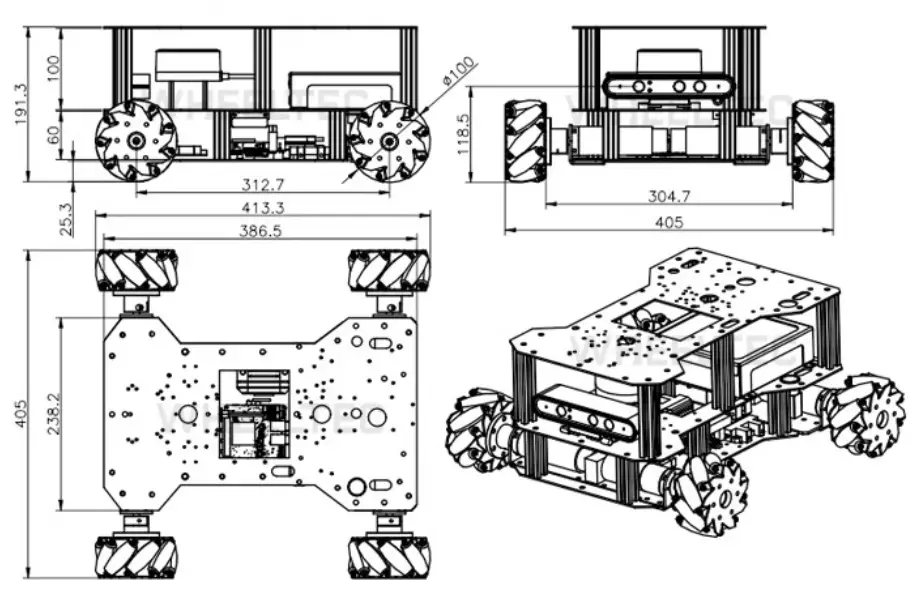
Mecabot Pro Design Diagram:
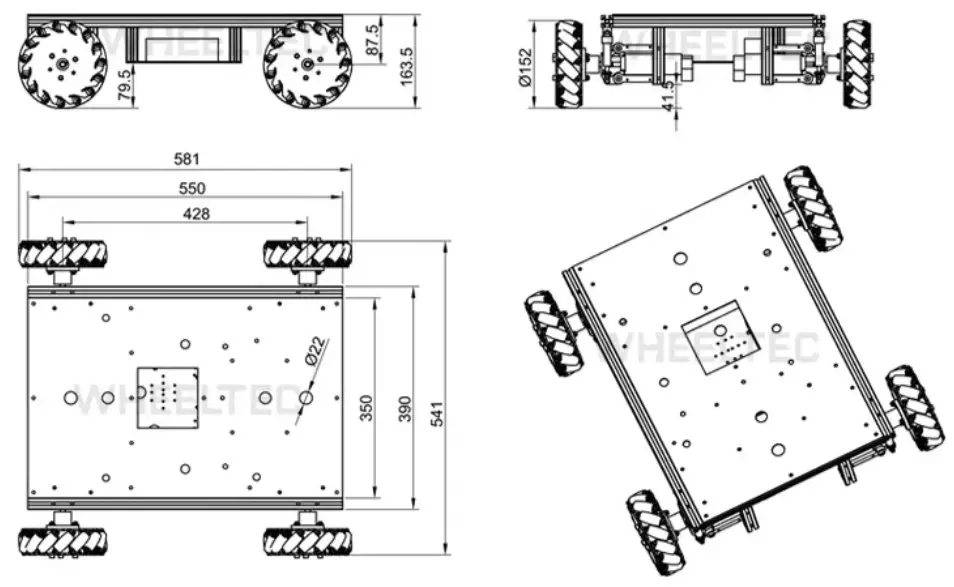
Mecabot Plus Design Diagram:

Mecabot X Design Diagram:

Power Management
All Mecabots come with a 6000 mAh Power Mag, a magnetic LFP (Lithium Iron Phosphate) battery and a Power Charger. Customers can upgrade the battery to 20000 mAh with additional cost. LFP batteries are a type of lithium-ion battery known for their stability, safety, and long cycle life. Unlike traditional lithium-ion batteries, which use cobalt or nickel, LFP batteries rely on iron phosphate, offering a more sustainable and less toxic alternative. They are highly resistant to thermal runaway, reducing the risk of overheating and fire. While they have a lower energy density compared to other lithium-ion batteries, LFP batteries excel in durability, with longer lifespan, faster charging, and better performance in extreme temperatures, making them ideal for electric vehicles (EVs) and energy storage systems. Power Mag can be attached to any metal surfaces of a robot due to its magnetic base design. It makes swapping batteries quick and easy.
Technical Specifications
| Model | 6000 mAh | 20000 mAh |
| Battery Pack | 22.4V 6000mAh | 22.4V 20000mAh |
| Core Material | Lithium Iron Phosphate | Lithium Iron Phosphate |
| Cutoff Voltage | 16.5 V | 16.5 V |
| Full Voltage | 25.55 V | 25.55 V |
| Charging Current | 3A | 3A |
| Shell Material | Metal | Metal |
| Discharge Performance | 15A Continuous Discharge | 20A Continuous Discharge |
| Plug | DC4017MM female connector (charging) XT60U-F female connector (discharging) | DC4017MM female connector (charging) XT60U-F female connector (discharging) |
| Size | 177*146*42mm | 208*154*97mm |
| Weight | 1.72kg | 4.1kg |
Battery Protection:
- Short circuit, overcurrent, overcharge, over-discharge protection, support charging while using, built-in safety valve, flame retardant board.
Auto Charging Station (Power+):
- Auto Charging Station is bundled with Rosbot 2+ model and can be purchased separately to work with Rosbot 2, Rosbot Pro and Rosbot Plus.
ROS 2 Quick Start
- When the robot is first powered on, it is controlled by ROS by default. Meaning, the STM32 chassis controller board accepts commands from the ROS 2 Controller – The Jetson Orin.
- Initial setup is quick and easy, from your host PC (Ubuntu Linux recommended) connect to the robot’s Wi-Fi hotspot. Password by default is “dongguan”.
- Next, connect to robot using SSH via the Linux terminal, IP address is 192.168.0.100, default password is dongguan.

- With terminal access to the robot, you can navigate to the ROS 2 workspace folder, under “wheeltec_ROS 2”
- Prior to running test programs, navigate to wheeltec_ROS 2/turn_on_wheeltec_robot/ and locate wheeltec_udev.sh – This script must be run, typically only once to ensure proper configuration of peripherals.
- You are now able to test the robot’s functionality, to launch the ROS 2 controller functionality, run: “roslaunch turn_on_wheeltec_robot turn_on_wheeltec_robot.launch”

- In a second terminal, you can use the keyboard_teleop node to validate chassis control, this is a modified version of the popular ROS 2 Turtlebot example. Type: “roslaunch wheeltec_robot_rc keyboard_teleop.launch”


Pre-installed ROS 2 Humble Packages
Below are the following user-oriented packages, whilst other packages may be present, these are dependencies only.
turn_on_wheeltec_robot
- This package is crucial for enabling robot functionality and communication with the chassis controller.
- The primary script “turn_on_wheeltec_robot.launch” must be used upon each boot to configure ROS 2 and controller.
wheeltec_rviz2
- Contains launch files to launch rviz with custom configuration for Pickerbot Pro.
wheeltec_robot_slam
- SLAM Mapping and localization package with custom configuration for Pickerbot Pro.
wheeltec_robot_rrt2
- Rapidly exploring random tree algorithm – This package enables Pickerbot Pro to plan a path to it’s desired location, by launching exploration nodes.
wheeltec_robot_keyboard
- Convenient package for validating robot functionality and controlling using the keyboard, including from remote host PC.
wheeltec_robot_nav2
- ROS 2 Navigation 2 node package.
wheeltec_lidar_ros2
- ROS 2 Lidar package for configuring Leishen M10/N10.
wheeltec_joy
- Joystick control package, contains launch files for Joystick nodes.
simple_follower_ros2
- Basic object and line following algorithms using either laser scan or depth camera.
ros2_astra_camera
- Astra depth camera package with drivers and launch files.
Copyright © 2024 Roboworks. All rights reserved.
Documents / Resources
 |
ROBOWORKS STM32F103RC Mecabot Autonomous Mobile Robot [pdf] User Manual STM32F103RC Mecabot Autonomous Mobile Robot, STM32F103RC, Mecabot Autonomous Mobile Robot, Autonomous Mobile Robot, Mobile Robot, Robot |

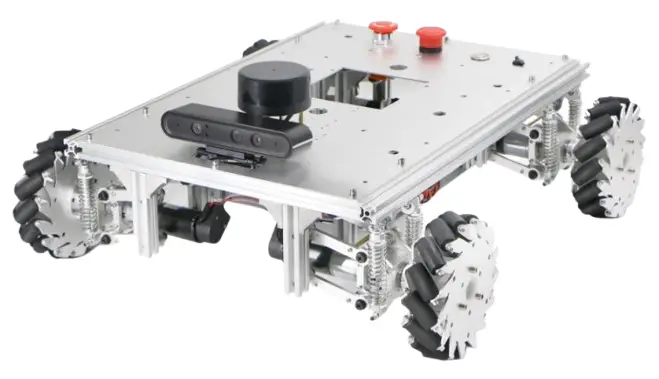
 supply for RTC and backup registers
supply for RTC and backup registers


